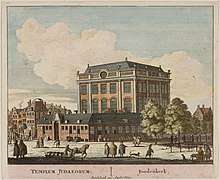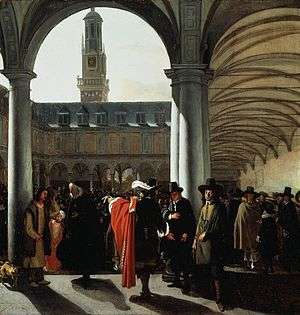Joseph de la Vega
José or Joseph Penso de la Vega, best known as Josseph de la Vega (ca. 1650 — Amsterdam, November 13, 1692), was a Spanish Jewish merchant, financial expert, moral philosopher and poet, residing in 17th century Amsterdam.[1] He became famous for his masterpiece Confusion of Confusions. Vega's work is the first study written about the Amsterdam Stock Exchange and its participants, the shareholders.[2] In it he describes the whole gamut, running from options (puts and calls), futures contracts, margin buying, to bull and bear conspiracies, even some form of stock-index trading.[3] The publication of Confusion de Confusiones helped lay the foundations for modern fields of technical analysis and behavioral finance.

Biography


Joseph Penso was born about 1650 into a family of Spanish and Portuguese Jews.[4] He was the son of Isaac Penso Félix (-1683) and of Esther de la Vega (-1679) who was a relative of the Vegas that founded a Talmudic school in Livorno. His father was a Marrano from Espejo, a small town in Córdoba province (Andalusia, Spain), who had made a solemn vow in the dungeon of the Inquisition that within a year after regaining his liberty he would openly profess Judaism. This oath he seems to have fulfilled in Middelburg after his escape to Antwerp.[5] He moved to Hamburg, where he married Esther de la Vega.[6] Sara, their first child, was born there in 1645.[lower-alpha 1] In an unknown year the family settled in Amsterdam.[lower-alpha 2] According to the marriage certificates in the Amsterdam City Archives, Joseph had three younger brothers: Abraham (ca 1656-1710) was a schoolmaster; David (1654-) and Raphael (ca 1659-) were merchants, who married on the same day in December 1687 two sisters Alvares Vega from Antwerp.[lower-alpha 3] Between 1700 and 1710 they acted as agents in London for Dutch investors.[10] The former moved to Dublin, see Ballybough Cemetery.
Joseph was taught by Isaac Aboab da Fonseca and Moses Raphael de Aguilar, members of the Talmud Torah community.[11] When in his eighteenth year he completed his first Hebrew drama, "Asire ha-Tiḳwah" ("Pardes Shoshannim"), in three acts, which appeared in Amsterdam in 1673 (2d ed., Leghorn, 1770), and in which he allegorically depicted the victory of the will over the passions. He married Rachel Alvaro (Alvares?)[12] His active commercial life began in Amsterdam in 1683,[13] after his father died. He became a respected merchant and an elegant Spanish poet, and filled the honorary offices of president of the Academia de los Sitibundos and in 1685 as secretary of the Academia de los Floridos, founded by Manuel de Belmonte.[14] Joseph de la Vega, who used his mother last name, wrote over 200 letters to different princes and statesmen, and was a prolific author, "the marvel of the academies, who made his work proof against criticism by presenting his subject in ordered form; delicate in his sentiments and of true refinement", as De Barrios ("Arbol de las Vidas", p. 90) characterizes him. Joseph de la Vega lived in the collapse of the Dutch East India Company, which financially ruined him.[15] Also Coenraad van Beuningen lost half a million guilder in 1688 through speculation in VOC shares. He wrote letters to the ecclesiastical authorities about the end of time and painted Hebrew or Kabbalistic signs on his house.[16] The funding of the armed invasion of William III in England caused a financial crisis in the Dutch Republic. Consequently, the financiers following William III to Britain possessed a full range of financial techniques, and for which they found a ready market indeed. This transfer of know-how formed the basis of derivatives trading in London, firmly linking Amsterdam's pioneering work to the emergence of modern markets.[17]
Confusion of Confusions (1688)


The book is written in Spanish; its original title is Confusión de Confusiones.[18] It was printed in Amsterdam, but published in Antwerp. Although not a descriptive account of the process of stock trading, Joseph presented the history of speculation in stocks and acquainted the reader with the sophisticated financial instruments used. The dialogue format allowed the reader to understand the respective perspectives of the various market participants and the intricacies of speculation and trading. There is evidence in Confusion de Confusiones of three major biases: herding, overconfidence and regret aversion.[19]
Joseph also came up with four basic rules of the share market that are still of the greatest relevance today:
The first rule in speculation is: Never advise anyone to buy or sell shares. Where guessing correctly is a form of witchcraft, counsel cannot be put on airs.
The second rule: Accept both your profits and regrets. It is best to seize what comes to hand when it comes, and not expect that your good fortune and the favorable circumstances will last.
The third rule: Profit in the share market is goblin treasure: at one moment, it is carbuncles, the next it is coal; one moment diamonds, and the next pebbles. Sometimes, they are the tears that Aurora leaves on the sweet morning's grass, at other times, they are just tears.
The fourth rule: He who wishes to become rich from this game must have both money and patience.
Confusion de Confusiones remained little known until the German economist Richard Ehrenberg published an influential essay in the 1892 Jahrbücher für Nationalökonomie und Statistik, “Die Amsterdame Aktienspekulation un 17. Jarhhundert.”[20]
In his honour, the Federation of European Securities Exchanges (FESE) awards since 2000 the annual De La Vega Prize to "young European researchers who distinguish themselves by outstanding research on the securities markets in Europe".[21]
Other works
Other of his works include:
- Discurso académico moral. Hecho en la Insigne Academia de los Sitibundos (Amsterdam, 1683; dedicated to Isaac Senior Texeira in Hamburg).
- Triunfos del águila y eclipses de la luna (ib. 1683).
- La Rosa, Panegírico Sacro, Hecho en la Insigne Academia de los Sitibundos (ib. 1683).
- Rumbos peligrosos por donde navega con título de novelas la zozobrante nave de la temeridad (Antwerp, 1684).
- Discursos académicos, morales, retóricos, y sagrados. Recitados en la Florida Academia de los Floridos (ib. 1685).
- Retrato de la Prudencia, y simulacro del Valor, al Augusto Monarca Guilielmo Tercero, Rey de la Gran Bretaña (ib. 1690).
Note
- When Sara Pensa married in 1669 her father Isaac assisted her. The couple had the City Archives four more daughters who married in Amsterdam and used either their father's or mother's last name: Jochebet or Jocqueba Pensa (1655-1718) and Ribca Penso (1662-1720) who married on the same day in 1685, and Abigail Penso (ca 1663-1708) and Lea Pensa (1664-1710).[7]
- In 1647 Moses Penso married Hester Pensa. They both came from Lisbon and lived on Vlooienburg. The couple was assisted by Raphael Penso and Abigail Pensa. They could have been Joseph' uncle, grandfather and aunts.[8]
- In 1687 David, Raphael and Lea lived in the "Vinckebuurt" which is Rapenburgerstraat.[9] This is the street where Abraham Penso lived and perhaps Joseph also.
References
- Biblioteca Española: Que Contiene La Noticia De Los Escritores Rabinos ...
- Teresa Corzo, Margarita Prat & Esther Vaquero (2014) Behavioral Finance in Joseph de la Vega's Confusion de Confusiones, Journal of Behavioral Finance, 15:4, 341-350, DOI: 10.1080/15427560.2014.968722
- De Vries and Van der Woude, p. 151
- https://www.jewishvirtuallibrary.org/penso-de-la-vega-joseph
- Confusion de Confusiones(1939)–Joseph de la Vega by G.J. Geers
- https://www.dutchjewry.org/portuguese_israelite_cemetery/popup.htm?../P.I.G./image/01961201.jpg
- https://www.dutchjewry.org/genealogy/vega/281.shtml; https://www.dutchjewry.org/portuguese_israelite_cemetery/p.shtml
- Amsterdam City Archives
- Biesen, F. van (2002) In het Bussenschuthofje, p. 3
- The Financial Revolution in England: A Study in the Development of Public ... by P.G.M. Dickson
- The Anglo-Dutch Moment: Essays on the Glorious Revolution and Its World Impact by Jonathan Irvine Israel, 451
- https://www.dutchjewry.org/portuguese_israelite_cemetery/popup.htm?../P.I.G./image/01961801.jpg
- Teresa Corzo, Margarita Prat & Esther Vaquero (2014) Behavioral Finance in Joseph de la Vega's Confusion de Confusiones, Journal of Behavioral Finance, 15:4, 341-350, DOI: 10.1080/15427560.2014.968722
- Confusion de Confusiones(1939)–Joseph de la Vega by G.J. Geers
- Teresa Corzo, Margarita Prat & Esther Vaquero (2014) Behavioral Finance in Joseph de la Vega's Confusion de Confusiones, Journal of Behavioral Finance, 15:4, 341-350, DOI: 10.1080/15427560.2014.968722
- A Concise Financial History of Europe Learning from the innovations of the early bankers, traders and fund managers by taking a historical journey through Europe’s main financial centers. Jan Sytze Mosselaar © 2018 Robeco, Rotterdam
- Amsterdam as the cradle of modern futures and options (1550-1650), p. 15 by Oscar Gelderblom and Joost Jonker. Utrecht University, 2005
- It is possible to read it in a full view mode here or buy here "Archived copy". Archived from the original on 2014-03-29. Retrieved 2014-04-18.CS1 maint: archived copy as title (link).
- Teresa Corzo, Margarita Prat & Esther Vaquero (2014) Behavioral Finance in Joseph de la Vega's Confusion de Confusiones, Journal of Behavioral Finance, 15:4, 341-350, DOI: 10.1080/15427560.2014.968722
- The First Book to Describe a Stock Exchange By Sotheby's
- Antoine Gattolliat (2011-06-16). "FESE - De la Vega Prize". Fese.be. Archived from the original on 2012-10-23. Retrieved 2012-10-18.
- Jewish Encyclopedia

External links
- FESE prize
- Pricing the Future: Finance, Physics, and the 300-year Journey to the Black ...by George G. Szpiro
- Penso's Roots: The Politics and Poetics of Cultural Fusion by Eleazar Gutwirth. Studia Rosenthaliana, Vol. 35, No. 2 (2001), pp. 269-284. Published by: Peeters Publishers. https://www.jstor.org/stable/41482458